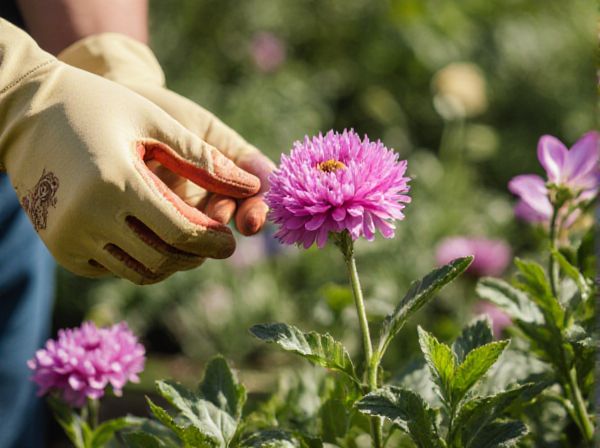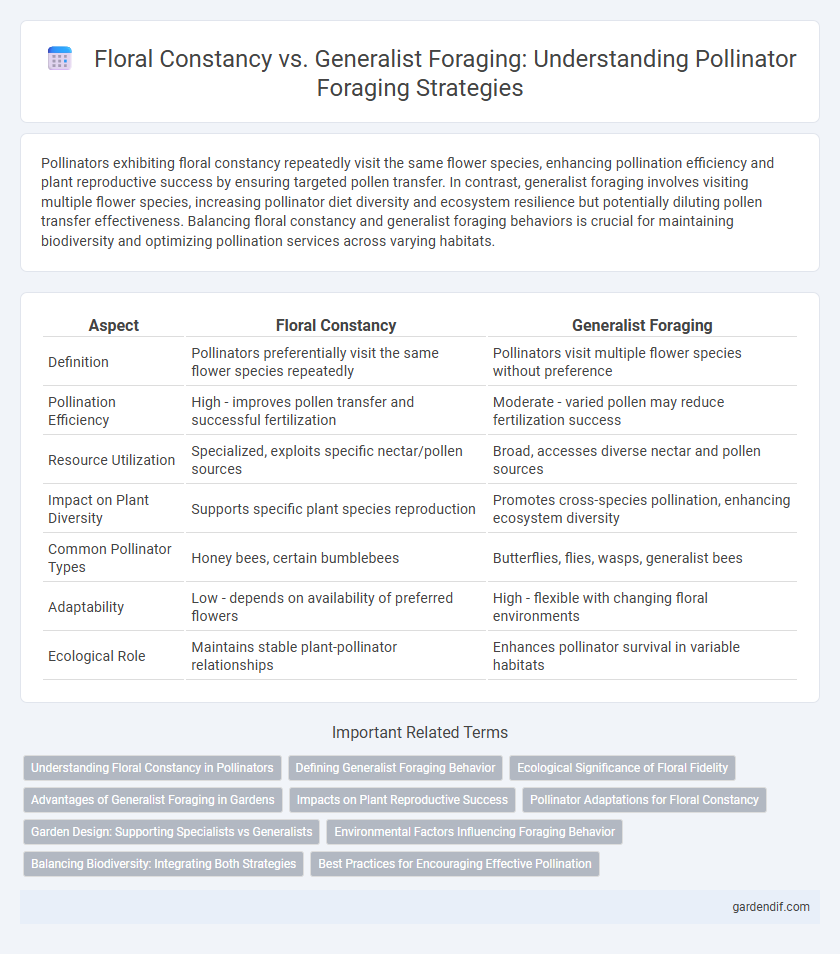
Floral Constancy vs Generalist Foraging Illustration
Pollinators exhibiting floral constancy repeatedly visit the same flower species, enhancing pollination efficiency and plant reproductive success by ensuring targeted pollen transfer. In contrast, generalist foraging involves visiting multiple flower species, increasing pollinator diet diversity and ecosystem resilience but potentially diluting pollen transfer effectiveness. Balancing floral constancy and generalist foraging behaviors is crucial for maintaining biodiversity and optimizing pollination services across varying habitats.
Table of Comparison
| Aspect | Floral Constancy | Generalist Foraging |
|---|---|---|
| Definition | Pollinators preferentially visit the same flower species repeatedly | Pollinators visit multiple flower species without preference |
| Pollination Efficiency | High - improves pollen transfer and successful fertilization | Moderate - varied pollen may reduce fertilization success |
| Resource Utilization | Specialized, exploits specific nectar/pollen sources | Broad, accesses diverse nectar and pollen sources |
| Impact on Plant Diversity | Supports specific plant species reproduction | Promotes cross-species pollination, enhancing ecosystem diversity |
| Common Pollinator Types | Honey bees, certain bumblebees | Butterflies, flies, wasps, generalist bees |
| Adaptability | Low - depends on availability of preferred flowers | High - flexible with changing floral environments |
| Ecological Role | Maintains stable plant-pollinator relationships | Enhances pollinator survival in variable habitats |
Understanding Floral Constancy in Pollinators
Floral constancy in pollinators refers to the tendency of individual pollinators, such as bees or butterflies, to consistently visit flowers of the same species during foraging trips, enhancing pollen transfer efficiency and plant reproductive success. This behavior contrasts with generalist foraging, where pollinators visit a wide variety of flower species, potentially reducing the precision of pollen dispersal. Understanding floral constancy is critical for studying pollination networks, biodiversity, and ecosystem stability, as it influences plant-pollinator coevolution and the maintenance of floral diversity.
Defining Generalist Foraging Behavior
Generalist foraging behavior in pollinators involves visiting a wide variety of flower species during foraging trips, allowing efficient resource utilization across diverse floral landscapes. This behavior contrasts with floral constancy, where pollinators specialize in a limited set of floral species, optimizing pollen transfer but reducing flexibility. Generalist foraging supports ecosystem resilience by enhancing pollination coverage and promoting genetic diversity among plant populations.
Ecological Significance of Floral Fidelity
Floral constancy enhances pollination efficiency by ensuring consistent pollen transfer between flowers of the same species, which is critical for successful plant reproduction and maintaining genetic diversity. This behavioral trait supports specialized plant-pollinator relationships, promoting ecosystem stability and resilience. In contrast, generalist foraging may increase pollinator diet breadth but often results in reduced pollination precision and potential pollen wastage.
Advantages of Generalist Foraging in Gardens
Generalist foraging in gardens enhances pollination efficiency by enabling pollinators to access a wide variety of floral resources, supporting plant biodiversity. This flexible foraging behavior increases resilience against temporal and spatial fluctuations in flower availability, improving ecosystem stability. Diverse pollen transfer promotes genetic variation in plants, benefiting garden health and productivity.
Impacts on Plant Reproductive Success
Floral constancy enhances plant reproductive success by increasing pollen transfer efficiency and reducing interspecific pollen contamination, leading to higher seed set and quality. Generalist foraging promotes cross-pollination among diverse plant species, which can enhance genetic diversity but may dilute pollen specificity, potentially lowering fertilization rates. Balancing floral constancy and generalist foraging strategies is crucial for optimizing plant pollination dynamics and reproductive outcomes.
Pollinator Adaptations for Floral Constancy
Pollinators exhibit specialized adaptations such as enhanced spatial memory and sensory receptor tuning that promote floral constancy, enabling efficient foraging on specific flower species. Neural mechanisms optimize recognition and handling skills, reducing energy expenditure and increasing pollination success for targeted plants. These adaptations contrast with generalist foraging strategies, where less specialization supports diverse floral visits but lower consistency.
Garden Design: Supporting Specialists vs Generalists
Designing a garden to support floral constancy involves selecting diverse native plant species that bloom sequentially, encouraging pollinators like specialist bees to repeatedly visit specific flowers and enhance efficient pollination. Conversely, incorporating a wide variety of flowering plants with overlapping bloom periods attracts generalist pollinators such as honeybees and butterflies, promoting broader foraging opportunities. Balancing specialist-friendly patches with generalist-friendly zones maximizes pollinator diversity and ecosystem resilience in garden habitats.
Environmental Factors Influencing Foraging Behavior
Environmental factors such as floral resource availability and diversity significantly influence pollinator foraging behavior, dictating whether they exhibit floral constancy or generalist foraging. Temperature fluctuations and weather conditions alter nectar production and accessibility, impacting pollinator preferences and foraging efficiency. Habitat fragmentation and pesticide exposure disrupt floral patch quality, often forcing pollinators to adopt more generalized foraging strategies to meet nutritional needs.
Balancing Biodiversity: Integrating Both Strategies
Floral constancy allows pollinators to efficiently transfer pollen within specific plant species, enhancing reproductive success and maintaining specialized plant-pollinator relationships. Generalist foraging expands pollinator diet diversity, supporting ecosystem resilience by promoting cross-pollination among multiple plant species. Balancing both strategies fosters biodiversity by combining specialization's efficiency with generalization's adaptability, crucial for sustaining dynamic ecosystems and diverse floral communities.
Best Practices for Encouraging Effective Pollination
Floral constancy, where individual pollinators repeatedly visit the same flower species, enhances pollen transfer efficiency and increases fruit set in crops. Encouraging a diverse pollinator habitat with native flowering plants supports both floral constancy and generalist foraging behaviors, maximizing pollination resilience. Implementing sequential bloom planting strategies ensures continuous floral resources, promoting sustained pollinator activity and effective pollination throughout the growing season.
Floral Constancy vs Generalist Foraging Infographic

 gardendif.com
gardendif.com